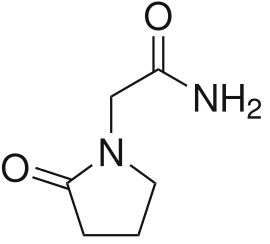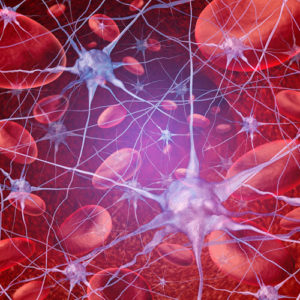Table of Contents
Piracetam (2-oxo-1-pyrrolidine-acetamide, Nootropil) is a water-soluble ampakine nootropic in the racetam-class of compounds.
Piracetam was first synthesized by Dr. Corneliu Giurgea at Belgian-based pharmaceutical company UCB Pharma in the 1964. Piracetam is considered the first true nootropic ever developed.
As a cyclic derivative of GABA, the drug Piracetam was first intended to be a calming type of drug for motion sickness. But in spite of its connection with GABA, Piracetam didn’t show any behavior associated with this calming neurotransmitter. And cannot directly affect GABA receptors.[i]
Instead, Dr. Giurgea discovered that Piracetam was able to boost cognition even in healthy people. The company launched this new ‘drug’ as ‘Nootropil’ in Europe in the early 1970’s. The success of Nootropil soon allowed UCB Pharma to expand its operations which led to many new pharmaceutical drugs.
Dr. Giurgea coined the term “nootropic” to describe this class of cognition-optimizing compounds.[ii] Nootropic was derived from the Greek words for “mind” (noos) and “towards” (tropein).
Piracetam is sold as a prescription drug (Nootropil and Lucetam) in Europe. In South America, Piracetam is sold under the names Noostan (Argentina), Breinox (Venezuela and Ecuador), and Nootropil (Mexico). Piracetam is also branded as Lucetam, Oikamid, Smart, Geratam, Biotropil, Neurobasal, Stimulan and Nocetan in countries around the world.
In the United States, Piracetam is sold as an OTC supplement as Piracetam and Nootropil.
Dozens of racetam derivatives have since been developed based on the original Piracetam. All synthetic compounds, racetams share a pyrrolidone nucleus.
Piracetam modulates AMPA receptors, and boosts the function of acetylcholine in the brain. A favorite racetam among the nootropics community. Neurohackers use Piracetam to boost cognitive function and learning and memory.
If you’re going to start experimenting with racetams, my recommendation at Nootropics Expert is to start with Piracetam. Because it works, it’s safe and it’s cheaper than all the other nootropics in the racetam-family.
Piracetam helps:
- Inflammation: Piracetam is a potent analgesic (anti-pain). This analgesic effect is related to inhibition of inflammatory markers including IL-1β. And the prevention of reduced glutathione, ferric reducing ability and free radical scavenging[iii]
- Neurotransmitters: Piracetam potentiates the flow of, and increases the effect of acetylcholine (ACh) in the brain.[iv] And studies have shown it significantly improves learning and memory.[v]
- Cerebral Blood Flow: Randomized controlled trials show Piracetam increases blood flow in the brain.[vi] Better blood flow delivers more oxygen and nutrients to neurons improving cognition, memory and focus.
What is Piracetam?
Piracetam (2-oxo-1-pyrrolidine-acetamide, Nootropil) was the first in the racetam-family of nootropic compounds. It is a water-soluble ampakine nootropic. AMPA (α-amino-3-hydroxy-5-methyl-4-isoxazolepropionic) refers to one of three glutamate receptors in your brain.[vii]

Developed by a fellow of famous Russian physiologist Ivan Pavlov, Dr. Corneliu Giurgea first synthesized Piracetam at Belgian-based pharmaceutical company UCB Pharma in the 1964.
Since the discovery of Piracetam, dozens of piracetam like drugs (nootropics) have been created in the racetam-class of compounds. And all have a pyrrolidone nucleus at their core.
Piracetam is a cyclic derivative of GABA. But oddly enough, it doesn’t affect GABA receptors in the brain. Instead, Piracetam was found to modulate AMPA and NMDA receptors and improve the function of the neurotransmitter acetylcholine (ACh).
AMPA and NMDA receptors along with acetylcholine are associated with learning and memory.[viii] And when Piracetam is stacked with a choline supplement its effects are even more pronounced. Researchers have shown in hundreds of clinical studies that Piracetam therapy significantly improves learning and memory.
Piracetam also increases regional cerebral blood flow. Blood delivers oxygen and glucose needed for cellular metabolism, and helps carry away cellular waste. Critical for the highly optimized brain.
Piracetam is sold as a prescription drug in many countries around the world. In the United States, Piracetam is sold as an unregulated OTC research compound.
How does Piracetam work in the Brain?
Piracetam boosts brain health and function in several ways. But two in particular stand out.
- Piracetam modulates AMPA and NMDA receptors in the brain. And improves the flow of acetylcholine (ACh) and sensitivity and density of ACh receptors.[ix]
This German study conducted with lab mice showed the pharmacological properties of Piracetam treatment elevated NMDA receptor density. And normalized the way those receptors worked with L-Glutamate similar to that of a healthy brain.
Deficits at the level of NMDA receptors could be one of the mechanisms of action underlying age-related cognitive decline. Studies show that nootropics like piracetam might act in part by restoring age-related deficits of central muscarinic cholinergic receptor density. And the researchers concluded that Piracetam showed cognition-enhancing properties.[x]
This effect on NMDA receptor sites is directly related to our interest in using Piracetam for Long-Term Potentiation and the support of long-term memory formation.
Neuroplasticity is dependent on activation of NMDA receptors.[xi] And this neuroplasticity is at the heart of memory formation. Reviews of Piracetam used by neurohackers frequently report the return of long-lost memories. Further proof of the efficacy in using Piracetam to support learning and memory.
- Piracetam increases cerebral blood flow. Several studies have shown how Piracetam positively influences brain blood flow. Cerebral blood flow is critical for cognitive function and the highly optimized brain. Blood delivers oxygen and local cerebral glucose utilization needed for cellular metabolism, and helps carry away cellular waste.[xii]
Strokes can be caused by an interruption in cerebral blood flow. Starving parts of the brain of oxygen and glucose. This double-blind, placebo-controlled study was done with 24 stroke patients. One group received 2,400 mg of Piracetam twice daily, and the other a placebo.
Before treatment, both groups were comparable in performance during language tasks. The study found that Piracetam treatment improved recovery of various language functions. And this effect was attributed to increased blood circulation to areas of the brain related to language. The placebo group showed very little improvement in areas of language.[xiii]
How things go bad
As we get older, our brain chemistry and metabolism changes. And it seems these changes are affecting younger and younger people.
↓ Recall, reaction time and learning capacity declines
↓ ATP energy levels decline
↓ Density of AMPA and NMDA receptors decline
↓ Acetylcholine levels decline
↓ Cerebral blood flow declines
All of these changes are contributing factors to age-related cognitive decline. Early signs of these effects can be seen in poor decision-making, difficulty learning, and even recalling simple things like an important appointment.
But even if you’re not concerned with the signs of aging, Piracetam can help.
Piracetam benefits
Piracetam helps increase blood flow in the brain, improves oxygen levels, enhances glucose use in brain cells, maintains brain cell mitochondria and ATP synthesis.
Piracetam is also a potent modulator of AMPA-sensitive glutamate receptors in neurons. It increases the density of specific binding sites for AMPA in neuronal synapses.[xiv]
Glutamate is the primary excitatory neurotransmitter in your brain. This glutamate activity by Piracetam affects alertness, focus, attention, memory and learning. And one of the reasons why neurohackers consistently report that Piracetam improves mental performance and memory.
Piracetam increases high-affinity choline uptake (HACU) which is the process that occurs in cholinergic nerve endings and facilitates acetylcholine (ACh) formation. Boosting ACh with Piracetam produces a powerful effect on learning and memory.[xv]
Piracetam also boosts choline receptor density in the frontal cortex. The area of your brain used for working memory and decision-making.[xvi]
ATP energy is critical to your brain’s survival. Brain cells must produce all of their own ATP from glucose and oxygen. This brain energy carbohydrate metabolism depends on cerebral blood flow, oxygen uptake and glucose. Piracetam enhances this glucose utilization, and increases ATP synthesis within brain cell mitochondria.[xvii]
And Piracetam has analgesic (anti-pain) benefits. This anti-pain action is linked to Piracetam’s anti-inflammatory properties.[xviii] Inflammation can cause pain, and studies have shown Piracetam can have profound effect on pain.
And clinical research shows Piracetam may reduce the incidence of painful sickle cell disease crises in those suffering from sickle cell anemia.. But the research is limited and some studies dispute the clinical efficacy of using Piracetam for sickle cell anemia.
Piracetam boosts the use of acetylcholine so you should add a good choline source. Try Alpha GPC or CDP-Choline with Piracetam. And give your brain the choline it needs.
How does Piracetam feel?
Most neurohackers report a noticeable benefit from Piracetam after about 2 weeks. Consider that Piracetam is modulating your brain’s chemistry. And this change is unlikely to occur immediately.
Your brain needs some time to adjust to the new change in acetylcholine (ACh) levels and how it uses it. Increased cerebral blood flow takes a while to bring up levels of oxygen and nutrients. And for your neuronal cells to respond. Your mileage may vary depending on your own neuro-chemical makeup.
Many suggest starting with an ‘attack dose’ for the first 3-days. A 3,000 mg ‘attack dose’ of Piracetam for example to start with theoretically gets more of the supplement into your system right away. So it takes less time to build up before you start feeling the effects.
From there step down to a maintenance dose and vary the quantity until you find your own sweet spot.
Once you begin to notice the effects of Piracetam you’re likely to feel a mood boost, less social anxiety, heightened creativity, improved verbal fluency and better memory.
Piracetam does boost your brain’s use of acetylcholine. So you will likely find that adding a good choline source (Alpha GPC or CDP-Choline) to your Piracetam stack helps.
Piracetam Clinical Research
 We have plenty of evidence that Piracetam improves memory in animals and people who are suffering from many types of cognitive impairment. Keep in mind that most of the scientific research available for nootropics is done with sick people trying to get well.
We have plenty of evidence that Piracetam improves memory in animals and people who are suffering from many types of cognitive impairment. Keep in mind that most of the scientific research available for nootropics is done with sick people trying to get well.
The return on investment for research at institutions and universities comes from treating diseases. And not from helping ordinary biohackers like us trying to get a competitive advantage at work or in school.
We can however extrapolate the findings from these studies and learn if and how something like Piracetam can help our memory and cognition. Once-in-awhile someone does take the time to conduct such a study on healthy people. Like this one done with normal, healthy volunteers.
Researchers gave this healthy group of participants four 400 mg capsules of Piracetam 3-times per day (4,800 mg total) for 14 days. No effects on memory were observed after 7 days during this experiment. But after 14 days verbal learning had significantly increased.[xix]
Piracetam Improves Cognition
Researchers in Belgium (where Piracetam originated) conducted an analysis of 19 double-blind, placebo-controlled studies done with patients suffering dementia or cognitive disorders and who took Piracetam.
The results of this meta-analysis demonstrated the difference between people who used Piracetam or used a placebo. The end result of this analysis provided compelling evidence for the usefulness of Piracetam in a diverse group of people with cognitive impairment and for boosting brain function.[xx]
Several studies and user reviews have shown that Piracetam dosage makes a difference. And unlike some other nootropics where you start at a lower dose and work your way up, with Piracetam I recommend you start at a higher suggested dose.
This study in Germany with 78 elderly patients showed that there was a significant difference in cognition improvement while dosing Piracetam at 1,600 mg 3-times per day. There was no difference in cognition with patients who received 800 mg 3-times per day.[xxi] Dosage matters when using Piracetam.
Piracetam Enhances ATP Production
Piracetam is used around the world to treat cognitive impairment in aging, brain injuries, dementia and Alzheimer’s Disease. Several studies show that Piracetam enhances ATP production, mitochondrial membranes and neurite outgrowth in neurons.
In this study, scientists investigated the effects of Piracetam on mitochondrial function. Human brain cells were treated with Piracetam under normal conditions and under conditions imitating aging and damage by ROS (reactive oxygen species). And with cells representing early-stage Alzheimer’s Disease.
The cells representing Alzheimer’s conditions showed impaired mitochondrial function under baseline conditions. Piracetam was able to restore this impairment in cells and shift mitochondrial function back to normal.
The researchers showed that the metabolic enhancer Piracetam is able to repair mitochondria in those with mild Alzheimer’s and return cell function back to normal.[xxii]
Piracetam for the Treatment of Tardive Dyskinesia
Tardive Dyskinesia is a serious, and often disabling movement disorder often caused by meds that are used to block dopamine receptors.
There is no current standard treatment for this disorder in mainstream medicine.
But this is where nootropics come to the rescue once again. A study conducted at Be’er Sheva Mental Health Center at Ben-Gurion University in Israel with 40 patients suffering with Tardive Dyskinesia.
Study participants were randomly assigned either 4,800 mg/day of Piracetam or a placebo for 4 weeks. The study authors concluded at the end of the study “Piracetam appears to be effective in reducing symptoms of tardive dyskinesia.”
Piracetam recommended dosage
Recommended Piracetam dosage is 1,600 mg 3-times per day. One Piracetam dose in the morning, and one in the early afternoon, and one later in the afternoon.
You will likely want to start with an ‘attack dose’ when you’re first starting out with Piracetam. Refer to the “How does Piracetam feel?” section of this article for more on ‘attack doses’.
Dosing Piracetam varies widely between neurohackers. Experimenting and finding the dose where you experience the most benefit is key. You may find a lower dose works well for you. Or you may find you need to increase your dose even more. Dosing Piracetam is directly related to your own unique neurochemistry.
Piracetam Side Effects
Piracetam is non-toxic. So is considered well-tolerated and safe.
As with many of the racetams, Piracetam can cause headaches because it boosts the use of acetylcholine in your brain. Choline supplements like Alpha GPC or CDP-Choline can help you avoid this side effect.
Many neurohackers find that stacking Piracetam with a choline supplement boosts the effect with improved memory and cognition. And this is supported in several research studies.[xxiii]
Where to buy Piracetam
Piracetam is sold in tablet, capsule and powder form. Tablets and capsules are usually 800 mg each.
I recommend Click for Cosmic Nootropic – Piracetam or Click for Science.bio- Piracetam who sell Piracetam as a “research” compound. It is sold to be used in an academic laboratory research setting. They go on to state “nothing we sell is intended for nor is it manufactured for diagnostic or therapeutic purposes in humans.”
In Europe, Asia, South America and some other countries around the world, Piracetam is a prescription drug. And sold under many different brand names (including Nootropil). Refer to the Introduction of this article for some of these brand names.
Nootropics Expert Recommendation
Piracetam 1,600 mg 3-times per day
 I recommend using Piracetam as a nootropic supplement.
I recommend using Piracetam as a nootropic supplement.
Your body does not make Piracetam on its own. So to get its benefits you must take it as a supplement.
If you’re going to start experimenting with racetams, our recommendation at Nootropics Expert is to start with Piracetam. Because it works, it’s safe and it’s cheaper than all the other nootropics in the racetam-family.
Piracetam is especially helpful for those suffering from most types of age-related cognitive decline.
Piracetam is also particularly useful to students and executives who want to enhance cognitive functioning, learning and memory.
You should use Piracetam with a good choline supplement like Alpha GPC or CDP-Choline. It helps boost neural acetylcholine, so demands the presence of more choline in your brain.
You can safely boost daily intake of Piracetam to 9,600 mg if needed. Studies have shown that Piracetam is completely non-toxic even at high doses. You may find however that a lower dose than our recommended amount works better for you.
I recommend Click for Cosmic Nootropic – Piracetam or Click for Science.bio- Piracetam









Join The Discussion - 219 comments
Johanna
March 31, 2022
Hi there, David.
I am so very thankful for all your hard work and diligence in drilling down into all this information for us. That’s an ADHD superpower. I have ADD, my son has ADHD and down syndrom. Your information is very helpful for us, all of this information is a challenging but beautiful puzzle to figure out.
I had been using Piracetam and Alpha GPC for nearly a month but was noticing that I felt like crying a lot of the time. Irritable and weepy. What should I use with this combo to counteract this feeling?
Thank you very much!
Johanna
David Tomen
April 1, 2022
Johanna, I suggest trying Alpha GPC on its own and see if you get the same reaction. If not then it may be that Piracetam is just the wrong supplement for you.
Ed
March 10, 2022
Hi David,
I’m currently having trouble with sleep that I think is being triggered by my piracetam usage, and I wanted to see if you could give me some advice on how to sleep while taking piracetam.
I am taking Piracetam, Lion’s mane, Bacopa, Ginkgo Biloba, and Saffron extract, all of which boost seratonin and acetalcholine.
I’m also taking Mind Lab Pro, Mind Lab Energy, Magmind, Grapeseed Extract, L-theanine, vinpocetine, and alpha-GPC.
Lastly, I combine all of this with either Rhodiola Rosea or Sulbutiamine (I tend to do one for one week, then swap to the to the other so I can avoid tollerance).
After exteneded use (and particularly when combined with coffee), my problem is that I keep waking up after about 5 hours of sleep, and I can not get back to bed. I’ve tried everything – melatonin, valarian, chamomile, passionflower, apigenin, Taurine, extra L-theanine, etc, etc. And nothing seems to help me not wake up so early.
I have two theories:
1. Especially since piracetam has such a long half life, in combination with all of those other actylcholine boosting suppements, my stack prevents my achetylcholine levels from naturally dropping in the evenings and when sleeping (which is apparently necessary for long, deep sleep).
2. Similarly, many of these supplements boost serotonin, and I think that a mild form of serotonin syndrome might be causing these early wake issues.
And so, I wanted to see if you could reccomend any antichlorogenic supplements and/or “anti-seratonin”supplements that can safely be combined with this stack, so that I can see if reducing my acetylcholine levels and/or seratonin levels while sleeping can help solve this issue.
Also, any other ideas you may have would be greatly appreciated!
Thank you,
Ed
David Tomen
March 11, 2022
Ed, those supplements do not increase physical levels of serotonin and acetylcholine in your brain. They help your brain to reuse what is already there. There is nothing in your stack that will cause Serotonin Syndrome unless you are also using an SSRI.
Check the mechanism of action for each supplement you are using including the half-life of each. If I do not include the half-life in my review on the supplement then Google it.
This is the sleep stack I use and recommend: 500 mg L-Tryptophan, 200 mg L-Theanine, 250 mg PharmaGABA, 500 mg Lemon Balm extract, and 20 mg CBD Oil. All taken about 60 minutes before bed.
Lauren S
March 9, 2022
Hi David,
Would there be a use of taking ALCAR AND Piracetam together or would that be duplication ? I read that ALCAR is a good mitochondria boost in addition to increasing acetylcholine ?
David Tomen
March 10, 2022
Lauren, ALCAR is good because it is a cofactor in the synthesis of acetylcholine. Piracetam potentiates the flow of, and increases the effect of acetylcholine (ACh) in your brain. So Piracetam will work far better if you increase acetylcholine. For that you need ALCAR AND either CDP-Choline or Alpha GPC. Each time you dose Piracetam.
Adam
January 14, 2022
Greetings David!
What would you recommend for a vocalist who struggle to sing clearly and in time with metronome during fast “rap” tempo? I mean something that would help with the “flow” during fast passages of text, we actually have aniracetam, does piracetam is any better in this case?
David Tomen
January 16, 2022
Adam, I think Aniracetam with a good choline supplement is a far better choice. At least that has been my experience.
Faris
December 15, 2021
Hi David, just wanna check… taking 1600mg 3 times a day meaning 4800mg per day is this the loading dose ( 3 days)or can I take it everyday? This is for severe TBI With disorder of consciousness…
David Tomen
December 16, 2021
Faris, 1,600 mg 3-times per day of Piracetam is the standard adult dosage. Some experienced neurohackers recommend 3,000 mg instead of 1,600 mg as the ‘attack dose’ for Piracetam for a couple of days when you are starting with this racetam. Their reasoning is use more at first so you experience the benefits of Piracetam quicker.
Dylan
October 20, 2021
Hi David,
I attack dosed piracetam for about 2 weeks and felt like I didn’t notice too much of the noted benefits. In fact, I started developing noticably large bags under and around my eyes making people comment “Do you have a black eye?”. I looked into this and saw one site saying this is a possible side effect.
I was wondering what advice you would have for me so I can have another attempt at getting the benefits from this?
I was taking it with Alpha-GPC (300mg’s per attack dose of piracetam).
Any help is always greatly appreciated from you David.
Regards,
Dylan
David Tomen
October 25, 2021
Dylan, the “attack dose” of Piracetam should only be used for the first 3 days and not two weeks. I’m not surprised that you experienced side effects from using such a large dose for so long.
If you did not experience the intended benefits of Piracetam within the first few days of using it chances are this supplement is the wrong one for you.
Yauheni
October 17, 2021
Hi David, what do you think about the 3.6-4.2 Piracetam + 250/500 cdp choline +huperzine a (once every three days) + vinpocetine(10) + b- complex vitamins + zinc +omega 3-6.
I haven ‘t received all this yet , while I take 1.2g Piracetam three times a day and once in the morning 120 g gingko + 250 dmae + zinc and eat 3-4 egg brews a day . I feel much more sociable , I began to think faster, I had good dreams and started remembering random things that happened a lot of years ago – there is an effect and I like it . But I can ‘t focus on one thing for a long time , I constantly change fucus for another thing . I also have the opportunity to replace/add noopept/aniracetam to the first stack ( about which the question is ) there are no other racem’s in my country . Thanks !
David Tomen
October 18, 2021
Yauheni, as long as it works for you the you’ve got a good stack. For sustained attention/focus you can try adding Creatine (https://nootropicsexpert.com/creatine/)
Terry
October 13, 2021
Is this a viable or safe way to take Science.bio offers Piracetam powder?
David Tomen
October 13, 2021
Terry, I do not understand your question. Are you asking if Science.bio is trustworthy? Or are you asking specifically about Piracetam?
Terry
October 15, 2021
yes, I am asking if Science.bio is trustworthy ?
David Tomen
October 15, 2021
Terry, yes Science.bio is trustworthy or I would not be recommending them.
Terry
October 23, 2021
Thank you for your recommendation.